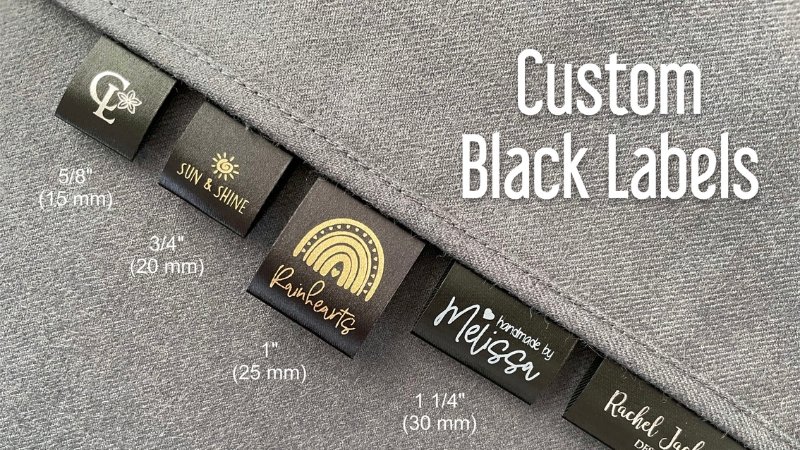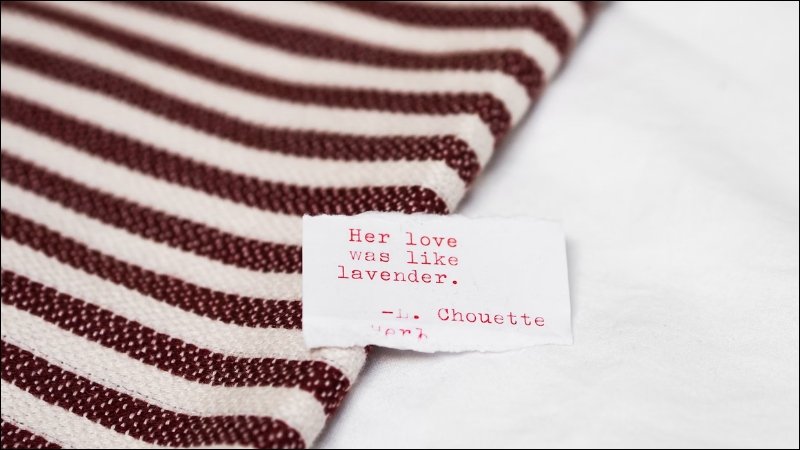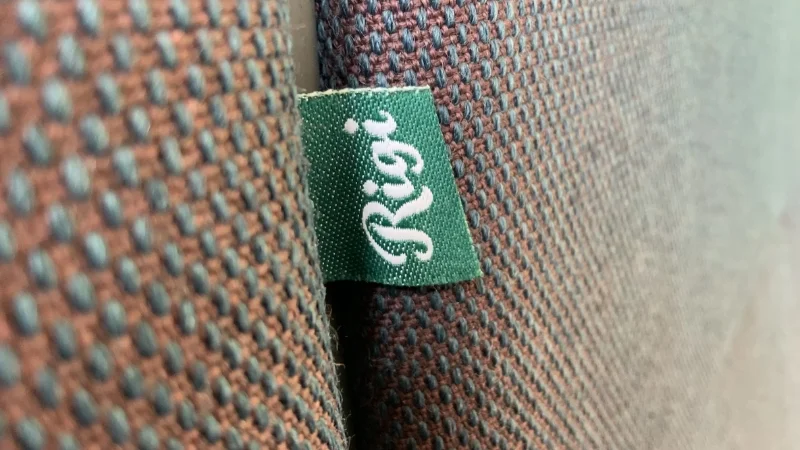Center fold labels: Key to a clean, branded finish
When considering the finer details that elevate a garment from simple clothing to a branded piece, the type of label used plays a crucial role. Among the various options, the center fold label stands out for its ability to deliver a polished and distinctly branded presentation.
Characterized by its simple yet effective design – folded precisely in the middle and typically sewn into a seam like the neckline or side seam – the center fold label creates a neat loop.
This specific construction is key to achieving that coveted clean, branded finish. It allows for prominent display of a brand logo or name on the visible portion while neatly tucking the sewn edge away, contributing to a professional and uncluttered interior.
Often serving as the primary brand identifier, the center fold label is a ubiquitous and effective choice for designers and brands looking to combine aesthetic appeal with clear brand communication directly within the garment itself. To fully understand their value, let’s delve into the specifics of center fold labels.
1. Understanding the Basics: The Center Fold Label Defined for Clothing Brands
1.1 Core Characteristics: What Makes a Label “Center Fold”?
A label that is folded exactly in the middle, creating two equal, symmetrical halves. This type of folded label is designed specifically for sewing into seam allowances during the garment’s construction phase. This means the raw top edges are tucked away within the seam, hidden from view.
Common materials include durable options like woven polyester (often in damask or taffeta weaves for detail) or smoother choices such as printed satin. The defining characteristic remains the central fold and the method of insertion into an existing seam, distinguishing this textile element from other label types.

1.2 Clearing Up Confusion: It’s Apparel Trim, Not a Magazine Page
While a general search for “centerfold” might bring up results related to magazine foldouts, within the apparel industry, the term refers exclusively to this specific type of clothing tag. This label serves as an important piece of garment trim and a key brand identity element, rather than printed media. Understanding this distinction is crucial when sourcing or specifying labels for clothing production.
2. The Advantages: Why Choose Center Fold Labels for Your Garments?
2.1 Achieving a Clean, Professional Finish
One primary benefit of the center fold label is the professional finish it provides. Because the label is folded and the raw edges are captured within the garment’s seam during garment construction, no cut edges are exposed.
The resulting clean edge presentation contributes significantly to a garment’s perceived quality and lends a more polished, high-end look, which can enhance customer perception of the brand.
2.2 Ensuring Durability and Longevity
Sewing the label directly into a structural seam offers superior durability and attachment. Unlike labels merely stitched onto the surface, a sewn-in seam label becomes an integral part of the garment’s structure. This significantly reduces the likelihood of the label detaching or fraying during washing and regular wear, contributing positively to overall garment quality and longevity.
2.3 Versatile Placement Options Across Apparel Item Types
Center fold labels offer considerable versatility in placement. While commonly found in necklines, their application extends to various locations depending on the apparel item and desired effect. Consider these placements:
- Side seams: Often used in dresses, blouses, trousers, and skirts, frequently holding care or secondary branding information.
- Waistbands: Integrated into the construction of trousers, skirts, or shorts.
- Cuffs: Can be subtly inserted into sleeve cuff seams.
- Pocket seams: Incorporated into internal or external pocket construction.
This flexibility across different garment seam construction points allows for consistent brand name visibility or information placement throughout a clothing line.
2.4 Symmetrical Display for Branding and Information
The inherent center fold creates a naturally balanced and symmetrical presentation. From a visual appeal perspective, this is often ideal for centering a brand logo design perfectly. Furthermore, this unique characteristic allows brands to present information effectively on both flaps; the two resulting ‘flaps’ or sides of the label can be utilized strategically – one side might feature the brand logo, while the other (often the back flap visible when lifted) could display size, origin, or basic care information.

3. Ideal Applications: Where Do Center Fold Labels Work Best?
3.1 Necklines: The Standard for T-Shirts, Sweaters, and Tops
The most classic placement for center fold labels is within the back necklines of garments like t-shirts, sweaters, blouses, and various tops. This neckline placement offers high visibility for the brand label upon purchase and handling. Typically, this location houses both the brand identity and the size designation. Careful material selection is advisable here to ensure comfort against the wearer’s skin.
3.2 Side Seams: Dresses, Skirts, Trousers, and Outerwear
For items like dresses, skirts, trousers, and even outerwear, inserting the label into a side seam is a frequent alternative. This placement is often preferred for the care label, containing detailed washing instructions and fabric content, keeping such information discreet yet accessible. Sometimes, brands use this location for subtle secondary branding or as a hemline detail.
3.3 Accessories and Creative Uses
Beyond standard garments, center fold labels find applications in accessories. They can be sewn into the sweatband seam of hats, integrated into internal or external seams of bags and pouches, or used creatively as a small external hem tag on sleeves or bottom hems for subtle apparel branding.
4. Important Considerations: Factors Before Choosing Center Fold Labels
4.1 Requirement of a Garment Seam
A fundamental point to understand is the limitation in application: center fold labels require insertion into a garment seam during the sewing process. They cannot be easily or neatly applied to a finished edge or surface after the garment is constructed without opening up an existing seam or creating an unprofessional finish. Production planning must account for this integration step.
4.2 Potential for Added Bulk
Because the label is folded, it doubles the material thickness at the insertion point. While often negligible, this added bulk can sometimes be a factor, particularly in very lightweight, delicate, or sheer fabrics where it might impact the drape or be noticeable to the wearer.
4.3 Design and Sewing Allowance Needs
Proper planning is essential regarding sewing allowance and design. Garment patterns must include sufficient seam allowance to accommodate the label insertion without compromising the seam’s integrity. Crucial information (like small text or logo elements) must be positioned carefully to avoid being lost within the fold or sewn into the seam allowance itself.
Precise sewing construction methods are needed for consistent placement.

5. Choosing the Right Fold: Center Fold vs. Other Label Types
5.1 Center Fold vs. End Fold Label
The primary difference lies in application and final appearance. A center fold label is looped and inserted into a seam. In contrast, an end fold label has its short ends folded under (either inwards or outwards) and is then sewn flat onto the garment surface, typically along the two folded short edges, leaving the long edges free. End folds sit on top of the fabric, whereas center folds emerge from within a seam.
5.2 Center Fold vs. Miter Fold Label
A miter fold label has its ends folded upwards at a 45-degree angle, creating pointed tabs used for sewing. This fold is often used for labels intended to be sewn around corners, onto sleeve hems, or used as hanger loops, providing a distinct diagonal finish at the attachment points. This contrasts with the straight, looped insertion of a center fold label into a linear seam.
5.3 Center Fold vs. Loop Fold & Manhattan Fold Label
A loop fold is functionally very similar to a center fold but often implies a longer label where the fold creates a loop, sometimes specifically designed as a locker loop for hanging. A manhattan fold represents a finishing technique rather than a primary fold type; often combined with a center or end fold, involves folding the top raw edge down and tucking under the main fold before sewing it into the garment.
This creates an exceptionally clean, fully finished top edge with no raw threads exposed, offering a premium look.
5.4 Quick Guide: When to Opt for a Center Fold
Consider a center fold label when:
- A symmetrical presentation is desired for branding.
- Standard neckline branding for tops is needed.
- Insertion into existing seams (side, waistband, cuff) is planned.
- A durable, classic, and cleanly integrated finish is the goal.
- Information needs to be presented on two distinct ‘flaps’.
| Feature | Center Fold | End Fold | Miter Fold |
|---|---|---|---|
| Appearance | Folded in half, emerges from seam | Ends folded under, sewn flat on surface (2 sides) | Ends folded at 45°, forms tabs, sewn on corners/edges |
| Pros | Clean edge in seam, durable, symmetrical display | Easy surface application, good for branding | Unique look for hems/corners, can form hang loop |
| Cons | Requires seam, potential bulk, needs allowance | Raw top/bottom edges may show, less integrated | Specific application, potentially more complex sewing |
| Common Uses | Necklines, side seams, waistbands, care labels | Neck patches, sleeve branding, pocket exteriors | Sleeve hems, bottom corners, external branding tags |
6. Practical Tips for Success with Center Fold Labels
6.1 Material Matters: Woven Label vs. Printed Label
Choosing between a woven label and a printed label impacts aesthetics, durability, and feel.
- Woven labels: Created by weaving threads together (commonly polyester). Damask weave offers high detail and density. Satin weaves provide a smoother surface but potentially less intricate detail. Taffeta is a basic, cost-effective option. Woven labels are generally very durable.
- Printed labels: Ink is printed onto a base material, often a smooth satin ribbon (typically polyester). Ideal for photographic detail, gradients, or very fine text. Can offer a softer feel against the skin, especially with high-quality satin. May be less durable to abrasion over many washes compared to high-quality woven labels. Consider the desired level of detail, required softness, budget, and longevity needs. (Fabric sourcing ethics can also be a factor in supplier choice, looking for responsibly sourced materials like recycled polyester).
6.2 Designing Your Center Fold Label
Effective label artwork preparation is key.
- Place the main brand logo centrally if symmetry is desired.
- Carefully consider what information will be visible on each ‘flap’ after folding and sewing allowance deduction.
- Allocate space clearly for size designation, care instructions guide symbols (using standard ISO Care Symbols), fabric content disclosure, and country of origin marking as required by regulations.
- Accounts for the fold line avoid placing critical small text directly on the fold.
- Provide artwork in vector format (like AI or EPS) for sharpest results, especially for woven labels.
6.3 Sewing Best Practices for a Professional Finish
Achieving a high-quality result requires attention during sewing.
- Alignment: Insert the label straight and perpendicular to the seam edge during garment seam construction. Use guides or markings for consistent placement across garments.
- Consistency: Ensure the label is caught securely within the stitching, but not so deep that information is obscured. Maintain a consistent depth from the seam edge.
- Thread & Stitch: Use appropriate thread color and weight that matches or complements the garment and label. A standard straight stitch is typical.
- Allowance: Double-check that the planned sewing allowance is sufficient to securely hold the label without compromising the seam strength.
- Machinery: While possible with standard machines, specialized folders or attachments on industrial sewing machines can improve speed and consistency for label attachment in high-volume production. Following these sewing best practices ensures the label integrates neatly and professionally.
7. Related Questions
7.1 Can center fold labels include washing instructions?
Yes, absolutely. This is a very common use. Often, the front-facing ‘flap’ displays the brand logo, while the reverse ‘flap’ (visible when lifted) contains the necessary washing instructions using standard ISO Care Symbols, along with legally required fabric content disclosure and country of origin information.
7.2 What are the typical minimum order quantities (MOQs) for custom center fold labels?
Minimum order quantities (MOQs) vary significantly between suppliers and depend heavily on the label type and material. Generally, woven labels may have higher MOQs (often starting in the 500-1000 piece range) compared to printed labels due to the setup involved.
Complexity, size, and number of colors also influence MOQs. The best approach is to inquire directly with potential custom label supplier companies for their specific requirements.
7.3 Are center fold labels comfortable against the skin?
Comfort depends largely on material choice and finishing. Printed labels on soft satin ribbon are typically very comfortable. For woven labels, satin weaves are softer than taffeta. The edge finishing method also plays a role; ultrasonic edge sealing produces a softer edge compared to heat-cut edges, which can sometimes feel scratchy, especially in sensitive areas like necklines.
Well-chosen materials and high-quality finishing prioritize wearer comfort.
Read more:
Center fold labels represent a classic and highly effective option for professional apparel branding. When integrated correctly into a garment seam, they offer a clean, durable, and symmetrical presentation that enhances perceived quality.
For small business apparel ventures, especially those operating in the wholesale clothing market, selecting the right label type and ensuring high-quality execution contributes significantly to overall brand recognition and customer satisfaction.
Thoughtful consideration of material, design, and placement ensures these small details make a powerful positive impact on your brand’s image. Exploring different label options and consulting with experienced suppliers can help determine the best fit for specific garment lines and branding goals.






















